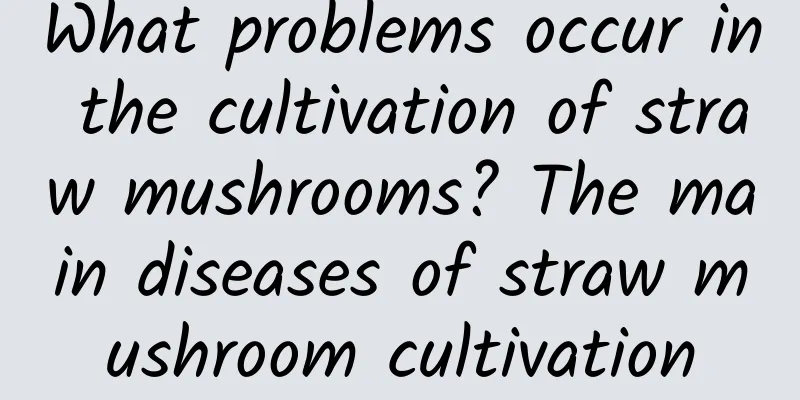What problems occur in the cultivation of straw mushrooms? The main diseases of straw mushroom cultivation

|
We often encounter various problems in the process of cultivating straw mushrooms, so today I will tell you about the various problems of cultivating straw mushrooms: 1. Bacterial contamination1. Main characteristics and causes of formation: mainly mold contamination, including green Trichoderma, Penicillium, Aspergillus and Neurospora. They mainly occur when cottonseed hulls and persimmons are used as raw materials for cultivation. This type of mold generally appears during the second wave of mushroom cultivation, grows on the surface or inside the culture medium, and affects the formation and growth of the fruiting body of the straw mushroom. The main reason for the occurrence is that the growth of the straw mushroom is weak and the pH value decreases in the later stage of cultivation. 2. Prevention and control methods (1) Use fresh, mold-free raw materials and expose them to sunlight for 2-3 days before use. (2) The culture medium is fully fermented. (3) After harvesting a wave of mushrooms, spray the surface of the material with lime water with a pH of 8.5-9. (4) When contamination occurs, sprinkle a layer of quicklime powder on the contaminated area. (5) Control the temperature and humidity, and strengthen ventilation to inhibit the growth of mold. (ii) Appearance of Coprinus comatus1. Main characteristics and causes of formation Coprinus comatus is also a kind of fungus, but it forms a fruiting body, which causes greater harm. The growth habits of Coprinus comatus and Volvariella volvacea are very similar. It appears about 2 days before Volvariella volvacea fruiting, and competes with Volvariella volvacea for nutrients, affecting the yield of Volvariella volvacea. In severe cases, Volvariella volvacea will be completely lost. After Coprinus comatus forms a fruiting body, it will open the cap quickly. It will rot and cause other fungi to occur. The main reason for the occurrence of Coprinus comatus is that too much nitrogen source is added to the culture medium, and the pH value of the culture medium is below 7, especially 5. 2. Prevention and control methods (1) The culture medium should be fully exposed to sunlight before use. (2) When adding auxiliary nitrogen sources, 5% bran is appropriate. (3) The culture medium should be fully fermented and the pH value should be adjusted to 8-9 before sowing. (III) The appearance of mushroom flies1. Main characteristics and causes of formation: The main cause is the damage of mushroom fly larvae (maggots), which eat the mycelium of straw mushrooms, causing the mushroom buds to wither or drill into the fruiting body to eat the flesh of the mushroom, causing the fruiting body to lose its commercial value. The occurrence of mushroom flies is mainly due to incomplete fermentation or the reproduction of adults on the culture medium. 2. Prevention and control methods (1) The culture medium is fully fermented to kill larvae or eggs. (2) Spray 0.5% dichlorvos around the mushroom farm. (3) Use 20w black light tubes and closed trays to lure and kill. Place the tubes 60cm above the top and place a collection tray 35cm below the light. Add an appropriate amount of 0.1% dichlorvos to the tray to kill the adult insects that fall into the tray. (IV) Dead Mushrooms1. Main characteristics and causes of occurrence: Small mushrooms shrink and die in large numbers. The main causes are as follows: (1) poor ventilation; (2) lack of water; (3) sudden temperature change; (4) acidic culture medium; (5) injury to small mushrooms during harvest; (6) degeneration of fungus; (7) contamination by other bacteria or occurrence of insect pests. 2. Preventive measures (1) Select excellent strains of bacteria (2) Prevent contamination by foreign bacteria and damage by pests and diseases (3) Timely adjust the pH of the culture medium to keep the pH at 8 and increase ventilation (5) Prevent sudden temperature rise and fall. |
<<: How to cultivate straw mushrooms? Things to note when growing straw mushrooms
>>: How to grow straw mushrooms? Straw mushroom cultivation techniques
Recommend
Loquat Flower
Introduction Loquat flower, a Chinese medicine na...
How is Ansaldo STS? Ansaldo STS review and website information
What is Ansaldo STS? Ansaldo STS SpA is an Italian...
How is Al Maktoum International Airport? Reviews and website information of Al Maktoum International Airport
What is the website of Al Maktoum International Ai...
What is the American Automobile Association? American Automobile Association reviews and website information
What is the American Automobile Association? The A...
The efficacy and function of perilla millet porridge
Perilla is a traditional Chinese medicinal materi...
Egg porridge ingredients and methods
I believe everyone is familiar with egg porridge....
The efficacy and contraindications of saffron
Safflower is an annual herb and the whole plant c...
How is Suriname TV? Suriname TV reviews and website information
What is Suriname Television? Suriname Television (...
How to cook lentils with pork residue
Braised lentils with pork scraps is delicious. My...
The efficacy and function of walnut and red dates
Walnuts and red dates are the most common and pra...
Is the date a date? The efficacy and function of the date
Date palm is a unique fruit produced in tropical ...
Benefits of Xiebai Congee
Xiebai porridge has many benefits. I will briefly ...
Is eating betel nut addictive? What are the dangers of eating betel nut?
Betel nut is particularly common in the southern ...
The efficacy and function of Paozi lotus root
Soaked lotus root is the part of lotus root. Many...
Can Wisteria be potted? How to plant Wisteria seeds?
Wisteria is an ornamental plant with a particular...









